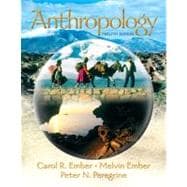
Note: Supplemental materials are not guaranteed with Rental or Used book purchases.
Purchase Benefits
What is included with this book?
| Introduction | |
| What Is Anthropology? | |
| How We Discover the Past | |
| Human Evolution: Biological and Cultural | |
| Genetics and Evolution | |
| The Living Primates | |
| Primate Evolution: From Early Primates to Hominoids | |
| The First Hominids | |
| The Origins of Culture and the Emergence of Homo | |
| Modern Humans | |
| The Emergence of Homo Sapiens | |
| The Upper Paleolithic World | |
| Origins of Food Production and Settled Life | |
| Origins of Cities and States | |
| Human Variation and Adaptation | |
| Cultural Variation | |
| The Concept of Culture | |
| Theoretical Approaches in Cultural Anthropology | |
| Explanation and Evidence | |
| Communication and Language | |
| Getting Food | |
| Economic Systems | |
| Social Stratification: Class, Ethnicity, and Racism | |
| Sex, Gender, and Culture | |
| Marriage and the Family | |
| Marital Residence and Kinship | |
| Associations and Interest Groups | |
| Political Life: Social Order and Disorder | |
| Psychology and Culture | |
| Religion and Magic | |
| The Arts | |
| Culture Change and Globalization | |
| Using Anthropology | |
| Applied and Practicing Anthropology | |
| Medical Anthropology | |
| Global Social Problem | |
| Table of Contents provided by Publisher. All Rights Reserved. |
The New copy of this book will include any supplemental materials advertised. Please check the title of the book to determine if it should include any access cards, study guides, lab manuals, CDs, etc.
The Used, Rental and eBook copies of this book are not guaranteed to include any supplemental materials. Typically, only the book itself is included. This is true even if the title states it includes any access cards, study guides, lab manuals, CDs, etc.